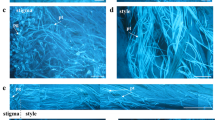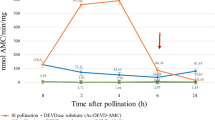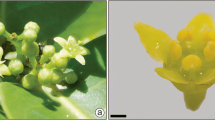Abstract
Programmed cell death (PCD) is a process that occurs both in animals and in plants and is an essential element in developmental processes. Pollination is a key factor in fruit production and self-incompatibility is one of the main limiting factors of this process. PCD has recently been put forward as a possible cause of pollen-growth arrest. As far as the olive is concerned, no data have been published concerning the mechanisms involved in hindering the growth of pollen tubes in incompatible pollen. Thus, we have studied olive pistils excised from freely pollinated flowers at different stages before and during the progamic phase using different cytochemical techniques, including trypan blue staining. To discover whether the elimination of incompatible pollen might be associated to PCD, we applied different tests to the excised pistils: (1) TUNEL assay; (2) DNA degradation analysis; (3) detection of caspase-3-like activity. Once we had determined that PCD was involved in pollen selection after free pollination, we conducted experiments after controlled pollination in pistils excised from flowers: (a) developing in the absence of pollen; (b) pollinated with sterile pollen that does not germinate; (c) self-pollinated; (d) pollinated with compatible pollen. Our results demonstrate that the growth of tubes in incompatible pollen is halted in the stylar area in a way that suggests the intervention of PCD. Furthermore, any pollen, even if sterile, seemed to accelerate PCD in papillar cells in the olive.








Similar content being viewed by others
References
Ateyyeh AF, Stosser R, Qrunfleh M (2000) Reproductive biology of the olive (Olea europaea L.) cultivar ‘Nabali Baladi’. J Appl Bot Angew Bot 74:255–270
Bonneau L, Ge Y, Drury GE, Gallois P (2008) What happened to plant caspases? J Exp Bot 59:491–499
Bosch M, Franklin-Tong VE (2007) Temporal and spatial activation of caspase-like enzymes induced by self-incompatibility in Papaver pollen. Proc Natl Acad Sci USA 104(46):18327–18332
Bozhkov PV, Filonova LH, Suarez MF (2005) Programmed cell death in plant embryogenesis. Curr Top Dev Biol 67:135–179
Burbridge E, Diamond M, Dix PJ, Mc Cabe PF (2006) Use of cell morphology to evaluate the effect of a peroxidase gene on cell death induction thresholds in tobacco. Plant Sci 171:139–146
Clarke PGH (1990) Developmental cell death: morphological diversity and multiple mechanisms. Anat Embryol 181:195–213
Collazo C, Chacón O, Borrás O (2006) Programmed cell death in plants resembles apoptosis of animals. Biotech Appl 23:1–10
Cuevas J, Diaz-Hermoso AJ, Galian D, Hueso JJ, Pinillos VMP, Sola D, Polito VS (2001) Response to cross pollination and choice of pollinisers for the olive cultivars (Olea europaea L.) ‘Manzanilla de Sevilla’, ‘Hojiblanca’ and ‘Picual’. Olivae 85:26–32
Danon A, Delorme V, Mailhac N, Gallois P (2000) Plant programmed cell death: a common way to die. Plant Physiol Biochem 38:647–655
de Nettancourt D (2001) Incompatibility and incongruity in wild and cultivated plants. Springer, Berlin
Díaz A, Martín A, Rallo P, Barranco D, De la Rosa R (2006) Self-incompatibility of ‘Arbequina’ and ‘Picual’ olive assessed by SSR markers. J Am Soc Hortic Sci 131:250–255
Domínguez F, Moreno J, Cejudo FJ (2001) The nucellus degenerates by a process of programmed cell death during the early stages of wheat grain development. Planta 213:352–360
Geitmann A (1999) Cell death of self-incompatible pollen tubes: necrosis or apoptosis? In: Cresti M, Cai G, Moscatelli A (eds) Fertilization in higher plants. Molecular and cytological aspects. Springer, Berlin, pp 113–138
Heslop-Harrison Y, Shivanna KR (1977) The receptive surface of the angiosperm stigma. Ann Bot 41:1233–1258
Hoeberichts FA, Woltering EJ (2003) Multiple mediators of plant programmed cell death: interplay of conserved cell death mechanisms and plant-specific regulators. BioEssay 25(1):47–57
Iakimova ET, Michalczuk L, Woltering EJ (2005) Hypersensitive cell death in plants—its mechanisms and role in plant defence against pathogens. J Fruit Ornam Plant Res 13:135–158
Ito J, Fukuda H (2002) Zen I is a key enzyme in the degradation of nuclear DNA during programmed cell death of tracheary elements. Plant Cell 14:3201–3211
Jordan ND, Franklin FCH, Franklin-Tong VE (2000) Evidence for DNA fragmentation triggered in the self-incompatibility response in pollen of Papaver rhoeas. Plant J 23:471–479
Keogh RC, Deverall BJ, McLeod S (1980) Comparison of histological and physiological responses to Phakopsora pachyrhizi in resistant and susceptible soybean. Trans Br Mycol Soc 74:329–333
Krishnamurthy KV, Krishnaraj R, Chozhavendan R, Christopher FS (2000) The programmed cell death in plants and animals—a comparison. Curr Sci 79(9):1169–1181
Lam E (2004) Controlled cell death plant survival and development. Nat Rev Mol Cell Biol 5(4):305–315
Malerba M, Contran N, Tonelli M, Crosti P, Cerana R (2008) Role of nitric oxide in actin depolymerization and programmed cell death induced by fusicoccin in sycamore (Acer pseudoplatanus) cultured cells. Phys Plant 133(2):449–457
Maraschin SF, Gaussand G, Pulido A, Olmedilla A, Lamers GEM, Korthout H, Spaink HP, Wang M (2005) Programmed cell death is involved in the transition from multicellular structures to globular embryos in barley androgenesis. Planta 221:459–470
McClure BA, Gray JE, Anderson MA, Clarke AE (1990) Self-incompatibility in Nicotiana alata involves degradation of pollen rRNA. Nature 347:757–760
Mutou Y, Ibuki Y, Terao Y, Goto R (2008) Induction of apoptosis by UV-irradiates chlorinated bisphenol A in Jurkat cells. Toxicol In Vitro 22(4):864–872
Reale L, Gromo S, Bonofiglio T, Orlandi F, Forniaceri M, Ferranti F, Romano B (2006) Reproductive biology of Olive (Olea europaea L.) DOP Umbria cultivars. Sex Plant Reprod 19:151–161
Reape TJ, Molony EM, McCabe PF (2008) Programmed cell death in plants: distinguishing between different modes. J Exp Bot 59(3):435–444
Sedgley M (1979) Structural changes in the pollinated and unpollinated avocado stigma and style. J Cell Sci 38:49–60
Serrano I, Suárez C, Olmedilla A, Rapoport H, Rodríguez-García MI (2008) Structural organization and cytochemical features of the pistil in olive (Olea europaea L.) var. Picual at anthesis. Sex Plant Reprod 21:99–111
Stone SL, Goring DR (2001) The molecular biology of self-incompatibility systems in flowering plants. Plant Cell Tissue Organ Cult 67:93–114
Suárez MF, Filonova LH, Smertenko A, Savenkov EI, Clapham DH, von Arnold S, Zhivotovski B, Bozhkov PV (2004) Metacaspase-dependent programmed cell death is essential for plant embryogenesis. Curr Biol 14(9):R339–R340
Takayama S, Isogai A (2005) Self-incompatibility in plants. Annu Rev Plant Biol 56:467–489
Thomas SG, Franklin-Tong V (2004) Self-incompatibility triggers programmed cell death in Papaver pollen. Nature 429:305–309
van Doorn WG, Woltering EJ (2005) Many ways to exit? Cell death categories in plants. Trends Plant Sci 10(3):117–122
Vergne P, Delvallee I, Dumas C (1987) Rapid assessment of microspore and pollen development stage in wheat and maize using DAPI and membrane permeabilization. Stain Technol 62:299–304
Wang C, Xu G, Jiang X, Chen G, Wu J, Wu H, Zhang S (2009) S-RNase triggers mitochondrial alteration and DNA degradation in the incompatible pollen tube of Pyrus pyrifolia in vitro. Plant J 57:220–229
Waspi U, Schweizer P, Dudler R (2001) Syringolin reprograms wheat to undergo hypersensitive cell death in a compatible interaction with powdery mildew. Plant Cell 13:153–161
Wu H, Cheung AY (2000) Programmed cell death in plant reproduction. Plant Mol Biol 44:267–281
Wu S, Collins G, Sedgley M (2002) Sexual compatibility within and between olive cultivars. J Hortic Sci Biotech 77:655–673
Wyllie AH (1980) Glucocorticoid-induced thymocyte apoptosis is associated with endogenous endonuclease activation. Nature 284:555–556
Zago E, Morsa S, Dat JF, Alard P, Ferrarini A, Inzé D, Delledonne M, Van Breusegem F (2006) Nitric oxide- and hydrogen peroxide-responsive gene regulation during cell death induction in tobacco. Plant Physiol 141:404–411
Acknowledgments
This work was supported by the Spanish MEC Project (BFU2006-09876/BFI). I. Serrano received a research fellowship from the Ministry of Science and Innovation and S. Pelliccione from the Spanish Council for Scientific Research (CSIC). We thank Mrs R. Luque and Mr F. Yerón (Ingesar S.L.) for their valuable technical assistance, Dr. C. Romero for his critical review of our paper and Dr. J. Trout for revising our English text.
Author information
Authors and Affiliations
Corresponding author
Additional information
Communicated by A. Feher.
An erratum to this article can be found at http://dx.doi.org/10.1007/s00299-010-0858-0
Electronic supplementary material
Below is the link to the electronic supplementary material.
Rights and permissions
About this article
Cite this article
Irene, S., Salvatore, P. & Adela, O. Programmed-cell-death hallmarks in incompatible pollen and papillar stigma cells of Olea europaea L. under free pollination. Plant Cell Rep 29, 561–572 (2010). https://doi.org/10.1007/s00299-010-0845-5
Received:
Revised:
Accepted:
Published:
Issue Date:
DOI: https://doi.org/10.1007/s00299-010-0845-5




